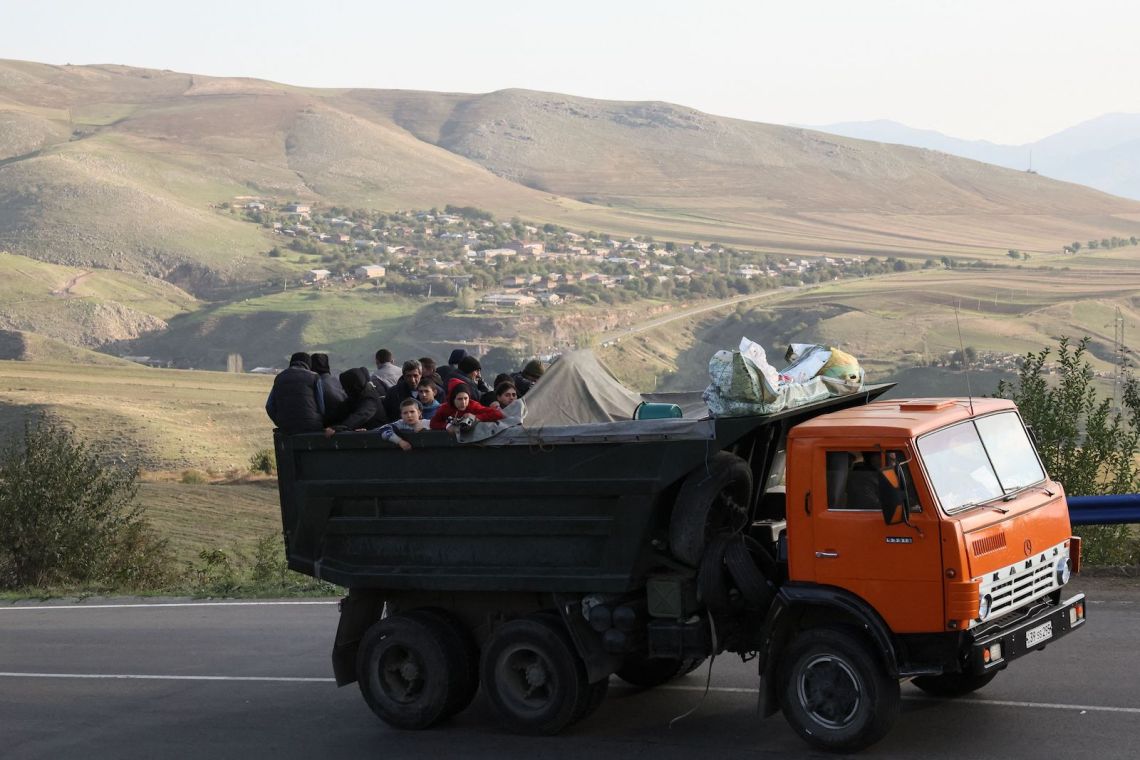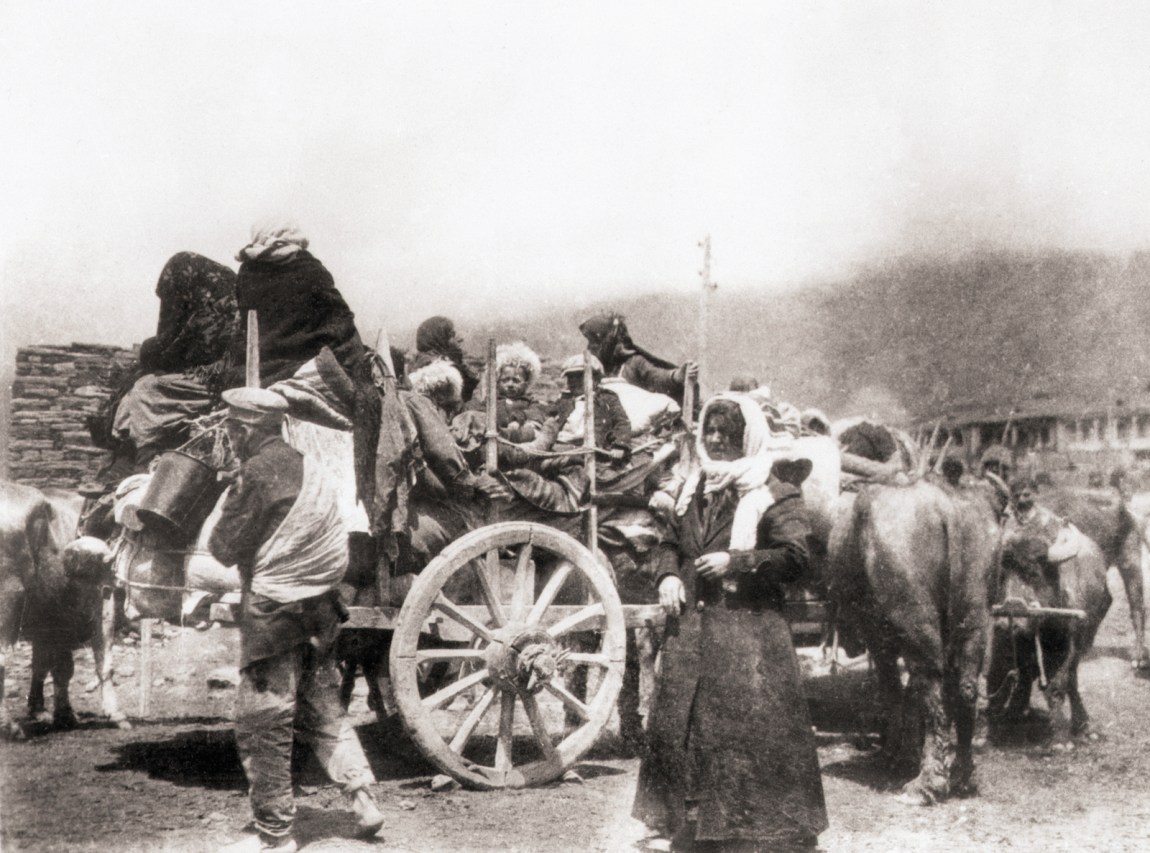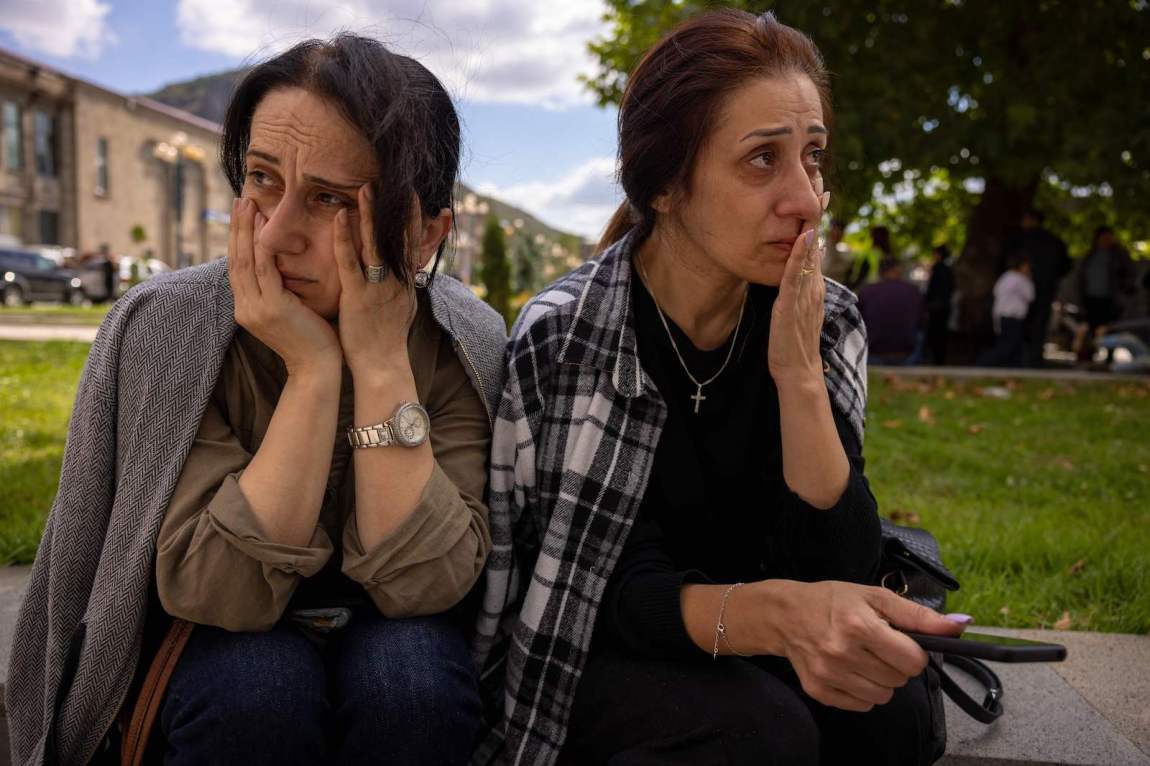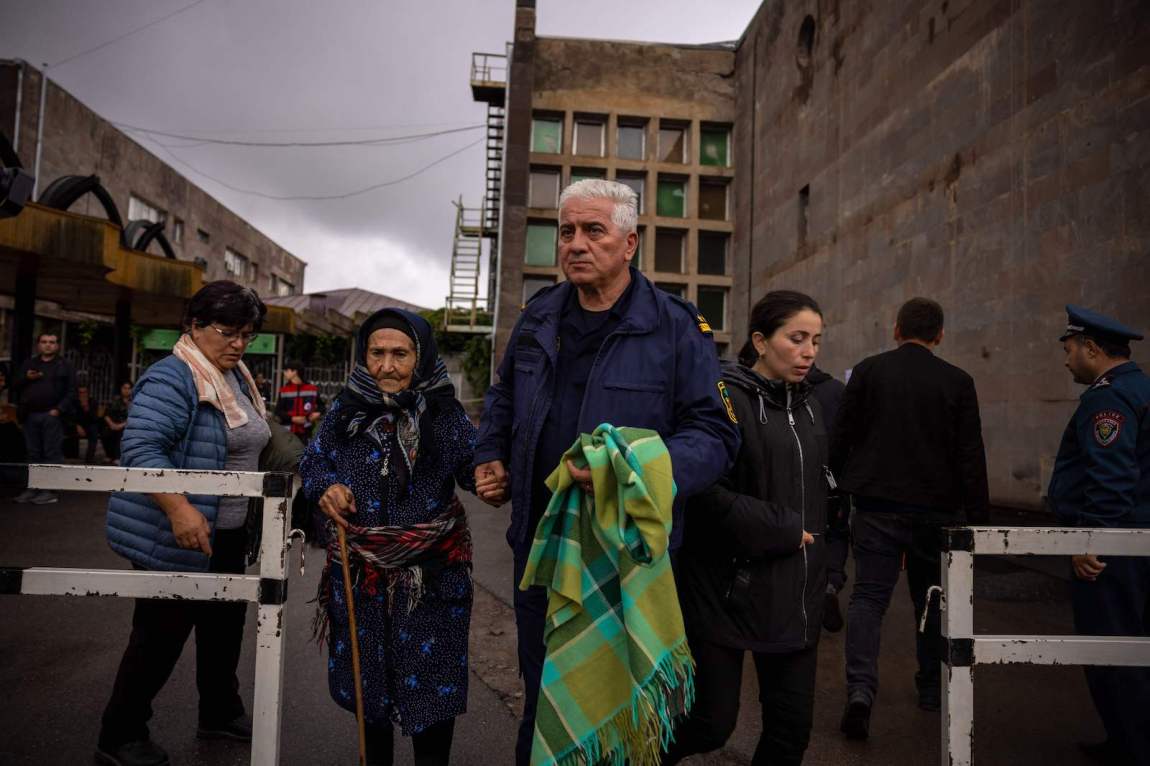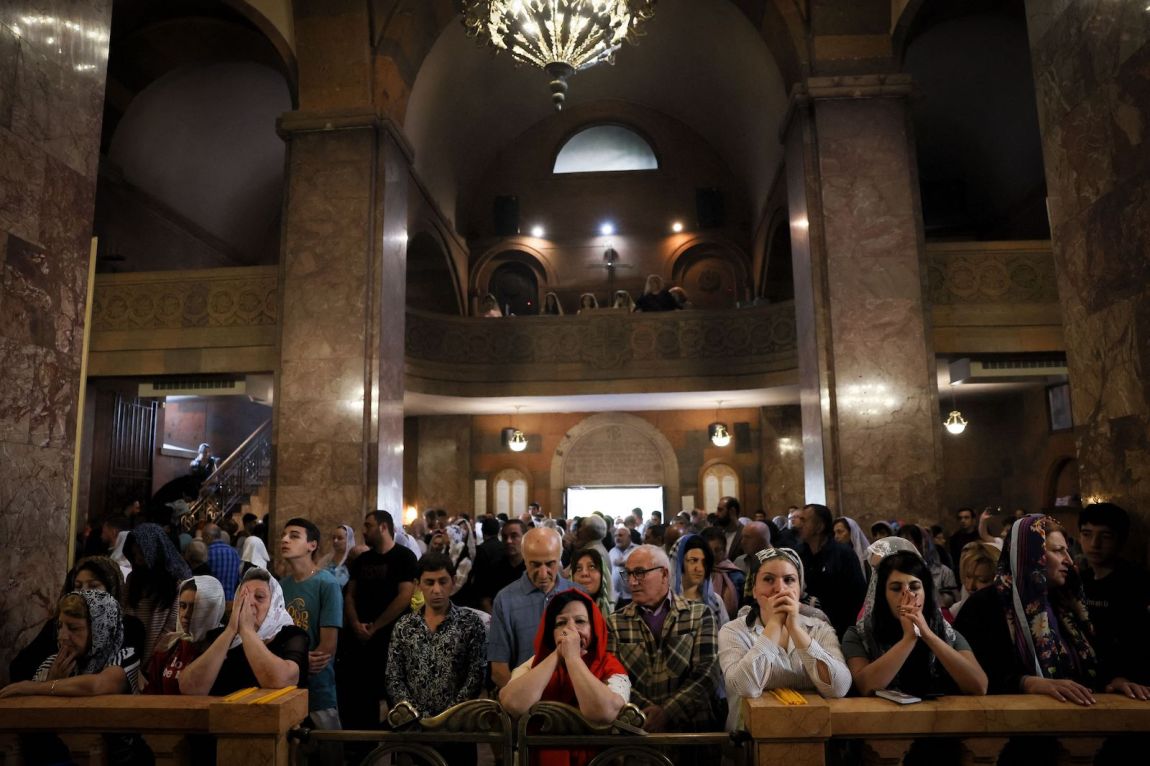This year marked the 850th anniversary of the death of the Armenian poet and apostle Nerses Shnorhali (Nerses the Graceful). Nerses, who had the arduous duty of leading the Armenian church soon after the dissolution of Armenia’s eastern kingdoms and the dispersion of its people, rose to the challenge by becoming a musical and poetic innovator, ingeniously conceiving of, among other things, the Bible as a book of riddles written in an accessible Armenian vernacular. The resulting volume is a compendium of the creation of the world. One of the riddles reads:
Though it is wingless, featherless,
It goes faster than the swallow.
It roams aimlessly from country to country,
It returns, it comes, bringing many guests. […]
It draws out the water of rivers from rivers,
It levels fortress, home, and hill.
The answer is mitk, a word that means mind, reason, advice, counsel, or meaning.1
Its strength is visceral. For the past twenty-one days, as I have heard and read accounts and analyses of Azerbaijan’s military seizure of Nagorno-Karabakh and the mass exodus of its Armenians, I’ve been thinking about how humans respond to the impunity of brute force by mobilizing the power of the mind. Nerses knew this mortal calculus well, in his fortress on the far reaches of Cilicia, the last Armenian kingdom. Once Cilicia fell to the Mamluks in 1374, Armenia would be without a state until 1918. Where was Armenia during that fallow, stateless period?2 It was everywhere and nowhere, it was wherever Armenians existed, in their mind’s eye, in their literature, art, architecture, monuments, manuscripts, and monasteries.
The end of September was a crash course for the West in the more recent history of the South Caucasus, whose mountains were once part of historic Armenia, and in particular the history of the autonomous region of Nagorno-Karabakh, an ethnic Armenian enclave within Azerbaijan. The seeds for this oldest of post-Soviet conflicts were sown in 1923, when Joseph Stalin designated majority-Armenian Karabakh as an autonomous oblast within Soviet Azerbaijan, part of the Soviet policy to integrate non-Russian nationalities into the USSR by weakening ethnic ties. During the 1960s Karabakh Armenians, subject to discrimination and persecution in Soviet Azerbaijan, unsuccessfully petitioned Moscow to annex the enclave to Soviet Armenia. In December 1991 Nagorno-Karabakh seized on the collapse of the USSR to declare independence from the Soviets, as the Baltic republics had done, but faced resistance from both Moscow and Azerbaijan.
The Armenians’ struggle for self-determination developed into a full-fledged war with Azerbaijan that lasted until 1994, when Russia brokered a cease-fire and the republic of Nagorno-Karabakh, or Artsakh, as it is known in Armenian, was established as a de facto separate state; the Karabakh Armenians also took control of seven adjoining Azeri districts, a sort of “security belt” that geographically united the region with Armenia. In September 2020 Azerbaijan initiated an offensive to retake the enclave and adjoining districts by force. After forty-four days of intense fighting and thousands of casualties, Russia once again brokered a cease-fire, and Azerbaijan took control of almost one third of the enclave and most of the districts. Nagorno-Karabakh was left with a single road, the Lachin corridor, connecting it to the outside world, and a Russian peacekeeping force charged with its protection.
This corridor, established for the unimpeded movement of persons, vehicles, and cargo between Nagorno-Karabakh and Armenia, was blockaded by Azerbaijan beginning in December of last year, violating internationally recognized human rights, flaunting a binding order by the International Court of Justice, and creating a humanitarian crisis that left the Karabakh Armenians on the brink of famine. As I wrote in these pages in February, the siege of the Lachin corridor was a military tactic to help Azerbaijan achieve its ultimate goal of emptying Nagorno-Karabakh of its 120,000 Armenian residents. By starving them and subjecting them to extreme psychosocial stress for nine months before attacking, Azerbaijan ensured that the final war over Nagorno-Karabakh would be swift and decisive.
At 1 PM on September 19, under the pretext of an antiterror operation, Azerbaijani forces began an offensive against Nagorno-Karabakh with heavy artillery and drones. In a recent roundtable hosted by the Council on Foreign Relations, the former ambassador and longtime humanitarian advocate Carey Cavanaugh dismissed the casus belli:
Nominally, Azerbaijan said that it had soldiers and two civilians killed by a landmine…. But in fact it became clear almost instantly this was a major military operation that had been planned in advance. They ended [up] seizing ninety positions around Karabakh. Since December with the blockade Azerbaijan has been testing the international waters to see what response would be given to moves they make.
The offensive came just five days after a State Department official warned Azerbaijan in uncharacteristically direct language before the Senate Foreign Relations Committee that the US “will not countenance any action or effort—short-term or long-term—to ethnically cleanse or commit other atrocities against the Armenian population of Nagorno-Karabakh.” But after the EU and US failed to take any concrete steps to force Azerbaijan to end its unlawful blockade—such as cutting aid to Azerbaijan and investment in oil and gas production, leveling targeted sanctions on individuals in the Azerbaijani government, or ensuring that aid organizations and international media could enter Nagorno-Karabakh—Azerbaijan calculated that it would face no real consequences for further aggression.
Advertisement
As if to underscore this certainty, Azerbaijan’s president, Ilham Aliyev, chose September 19, two days before Armenia’s independence day and the first day of the seventy-eighth session of the UN General Assembly’s High-level Week, when all the major heads of state were gathering in New York, to attack Nagorno-Karabakh. As Thomas de Waal, a writer and senior fellow at Carnegie Europe, pointed out three days after the invasion,
In the darker European order of the past decade, where normative values and a multilateral framework have been devalued, Azerbaijan cares less about statements of condemnation from Western governments. The key thing is almost certainly the support of two regional powers and neighbors: the full backing of Türkiye and deliberate equivocation from Russia, which looks more concerned about keeping its military base on the ground in Azerbaijan and humiliating the government in Yerevan than in ensuring the rights of local Karabakh Armenians.
Azerbaijan’s blitzkrieg lasted a single day before the Karabakh authorities agreed to a punishing cease-fire. In the days that followed, the bombarded civilian population was still without food, water, telecommunications, and electricity. More than seven thousand people were evacuated from sixteen villages near the frontlines, and there were reports of more than two hundred deaths, including civilians and children, with at least one eyewitness report of Azeri forces targeting civilian infrastructure. Without telecommunications, the number of casualties could not be confirmed by hospitals and there has been little public information about the missing and wounded. As Azeri forces advanced, people gathered by the thousands in Stepanakert, the region’s capital, congregating at the city’s airport, where the Russian peacekeepers were based and where they hoped in vain for medical aid, airlifts for the wounded, and humanitarian assistance. Despite Karabakh’s surrender, the Armenian news site CivilNet reported that Azeri soldiers continued to fire on the capital.
Shock prevailed, both within and without Nagorno-Karabakh’s borders, but this shock reverberated differently for Armenians than for non-Armenians. For those who had been warily watching Azerbaijan’s military buildup over the past few years—a 40 percent increase in the defense budget since 2020, to $3.1 billion; Israeli arms shipments earlier in the month; threats from Baku that free elections in Nagorno-Karabakh on September 9 (which took place as scheduled) would mean war; and, most obviously, the nine-month blockade—it seemed all too clear that Azerbaijan had no intention of letting the region exist in peace. The shock Armenians around the world express at losing Nagorno-Karabakh is the shock not of the unexpected but of dreaded inevitability.
And yet in The New York Times’s first comprehensive article about the conflict, on September 27, the subheading read: “After decades of wars and tense stalemates, almost no one saw it coming.” Such a statement says more about American interests and blind spots than about the facts on the ground. “Many in Brussels and Washington feel shocked and betrayed by Azerbaijan’s use of force,” De Waal wrote in Strategic Europe, because “up until the last minute” Aliyev “was reportedly assuring high-level interlocutors—including European Council President Charles Michel and US Secretary of State Antony Blinken—that he would not launch a military operation.” It is galling to see such susceptibility to a despot’s promises, but it is hardly surprising. Since US energy companies took an interest in Azerbaijan’s huge oil deposits in 1996, that interest has governed US State Department policy in the region. Beginning in 1997, when Congress lifted the sanctions it had levied on Azerbaijan for human rights violations that were still ongoing, the US and the EU have ensured Baku’s sense of impunity by proceeding with energy contracts and transportation talks even as they warned against aggression toward the Armenian population.
Armenians had been determined in their attempts to call attention to this tragedy before it was too late, despite the ostrich effect of powerful bystanders such as the EU and the US; the inaction of Russia, Nagorno-Karabakh’s security guarantor; and the capitulation of the Armenian government. After Armenia’s concessions in the 2020 peace agreement, Baku began pushing Yerevan for a more comprehensive settlement, namely to restore diplomatic relations, resolve the issue of Nagorno-Karabakh, settle border disputes between the two countries, and create a transportation corridor that would allow passage through Armenia to Nakhichevan, an Azeri exclave sandwiched between Armenia’s western border and Turkey. Armenians blame their prime minister, Nikol Pashinyan, for his conciliatory stance and willingness to participate in the peace talks even as Baku pursued military gains by launching attacks in Nagorno-Karabakh and Armenia proper in 2022. Pashinyan failed to put an end to the blockade, and in May of this year he agreed to recognize Azerbaijan’s territorial integrity over the Nagorno-Karabakh region, in return for the protection of the rights and safety of the Karabakh Armenians; Azerbaijan refused this compromise.
Advertisement
The Western media have only helped to strengthen Azerbaijan’s position, often echoing statements by Aliyev and the state-owned Azerbaijani media without scrutiny. The indigenous Armenians have been commonly described as “separatists,” their autonomous oblast a “breakaway enclave.” Even the Armenians’ will to self-determination and desire for democratic rule in the face of autocracy and racist hatred is summarized as a two-sided “bloody conflict” in the remote Caucasus. Luis Moreno-Ocampo, the first chief prosecutor of the International Criminal Court, decried the danger of this ambivalence in an op-ed in The Washington Post. “Today, as always, geopolitics explain the world’s reticence,” he wrote. “Azerbaijan is an ally with the West against Iran; it provides energy to Europe and it spends millions on sophisticated Israeli weapons. But such exigencies must not get in the way of the world’s responsibility to stop what is happening before its very eyes: the Armenian genocide of 2023.”
On September 22, soon after the cease-fire but before the Lachin corridor had been reopened, the Lemkin Institute for Genocide Prevention issued an SOS alert warning that “unconfirmed reports of atrocities and massacres” in Nagorno-Karabakh had been circulating: “Azerbaijani social media channels have openly threatened civilians with abuse, ranging from bounties on missing children to images and reports of massacres of residents who refused to leave their homes, leading to frantic civilian efforts to evacuate ahead of the arrival of the Azerbaijani military.”
*
When the Lachin corridor was finally reopened on September 24, tens of thousands of Karabakh Armenians began an exodus by means of the road whose blockade had been the instrument of their starvation. A drive that would normally take just over an hour stretched into days as Azerbaijani forces held people up at the border checkpoint. In the course of a week, nearly three quarters of the population fled into Armenia. Siranush Sargsyan, a native of Nagorno-Karabakh and a freelance reporter formerly based in Stepanakert, was among them. She had lost family members and property in the 2020 war and had become one of the 90,000 internally displaced persons in Yerevan. After the peace agreement between Russia, Azerbaijan, and Armenia was signed on November 10, 2020, she returned to Nagorno-Karabakh with thousands of others, reassured that their security was guaranteed.
Now there are no such guarantees. Siranush described the terror as palpable and omnipresent:
For the past nine months they have blockaded us, held us under siege, used every kind of threat—psychological threats, threats on social media, agricultural terror. They attacked villagers, people working in the fields, they didn’t allow us to harvest food. After starving us, they knew we had no strength, they just attacked…. I stayed until the Azeris entered Stepanakert. When they abducted villagers from the streets I still wanted to stay, I wanted to stay even more, those last days, my last hours…. We really want to live in our country but it’s not possible that they live there and we live there. They want to kill us, erase us, and live in our country. It’s what they did a hundred years ago, in 2020, and again now.
What many geopolitical analyses of the end of Nagorno-Karabakh have failed to understand is the active presence of the Armenian genocide—not only the historical memory of the catastrophe but also Turkey and Azerbaijan’s ongoing denial of it—in all its horror. The methods of denial employed by the Turkish and Azerbaijani states are multiple and diverse. They include, as the scholar Marc Mamigonian has enumerated,
the use of diplomacy and political pressure, the carrot and stick of economic benefits and sanctions, projecting a positive image of Turkey as a staunch NATO ally and a land of tolerance, reframing the Armenian Genocide as an episode of “common suffering,” accusing Armenians of genocide toward Turks and Azerbaijanis, disseminating an alternative “contra-genocide thesis” that seeks the status of academic legitimacy, and a campaign of legal activism and intimidation deployed, most notably, against educational institutions.
“Scholars have defined the denial of genocide as the last stage of genocide itself,” Bedross Der Matossian, a scholar of modern Middle East history, has written:
Denial is not only the reluctance to acknowledge the historical injustices of the past but it further aims at killing the dead and their memory over and over, inflicting pain on the survivors and their descendants, and demonstrating that future acts of violence are possible in a climate of deception and impunity. By denying genocides, states and nonstate actors become complicit in the process of genocide, transmuting the violence from the physical to the psychological plane.
What Der Matossian describes is happening now: the psychological pain of the refugees and the fulfillment of those future acts of violence. During the Holocaust, the Polish lawyer Raphael Lemkin formulated a definition of genocide that was purposefully expansive, signifying not necessarily the mass killing of an ethnic group but “a coordinated plan of different actions aiming at the destruction of essential foundations of the life of national groups, with the aim of annihilating the groups themselves.” It is the coordination of different actions—by Azerbaijan, with Turkey’s support—aimed ultimately at the elimination of the Karabakh Armenians that makes the current violence continuous with the past and the forced exodus a genocidal act.
As Siranush was stuck for days in the convoy of cars along the Lachin corridor, she posted to social media a video interview with a seventeen-year-old girl, Milena, sitting on the side of the road:
After having seen everything, it pains me to be leaving Artsakh, but I have hope that I’ll be able to come back. In terms of wanting to stay in Artsakh, Artsakh is one of the paradises on earth that cannot be traded with or compared to lands or wealth. The world should not believe that we are willingly leaving [Artsakh] ever. We fought till the very end, with our blood, with our lives to protect our country. Let nobody ever believe that the people of Artsakh [voluntarily] left—
A car horn starts honking and the video ends.
On September 28 Samvel Shahramanyan, the former president of the now defunct Republic of Artsakh, signed a decree stating that “Nagorno-Karabakh (Artsakh) will cease to exist” as of January 1, 2024, at which point all state institutions and agencies will be dissolved. Over 105,000 refugees have now entered Armenia and there are rumors that Azerbaijan may close the border at the Lachin corridor. I spoke with Zara Amatuni, a communications and prevention manager with the International Committee for the Red Cross (ICRC), who was in the Armenian border town of Goris, where refugees had arrived by the thousands. She told me that the ICRC has been focused on evacuating the wounded, sick, and dead and on supplying body bags and medicine to the local health and forensic facilities. Over the last two weeks, the ICRC transferred to Armenia the bodies of 229 people killed in connection with recent hostilities and an explosion, on September 25, of a fuel depot where civilians were lining up to refuel before leaving Stepanakert.
The ICRC is also assessing the needs of vulnerable people who fled to Armenia and supporting those left behind in Karabakh, as well as trying to find the missing. The UN Children’s Fund, which is now in Goris along with the World Food Program, estimated on Friday that “30 percent of those arriving [in Goris] are minors and many have been separated from their families.” According to an estimate from the UN mission to Karabakh, only between fifty and a thousand ethnic Armenians remain. Some are elected officials who have been arrested by the Azerbaijani government and charged with terrorism. While necessarily limited in scope in order to gain access, the mission reported that it “was struck by the sudden manner in which the local population left their homes and the suffering the experience must have caused.”
The people are gone but their monuments are still standing in the mountains, where they are in desperate need of preservation and study. “The region of Artsakh is studded with Armenian churches, monuments, cemeteries, and structures from bridges to residences that attest to the Armenian presence in the region going back for centuries,” the scholar Christina Maranci told me. Perhaps the most historically significant site is Amaras monastery, where Mesrop Mashtots, who developed the Armenian alphabet and the first Armenian liturgical chants, known as sharakans, established a school in 410 AD. There are monasteries from the fifth, sixth, and seventh centuries, such as Mokhrenes and Vankasar and Tsitsernavank, close to the Lachin corridor, which fit into a much larger corpus of Armenian architecture; there is the thirteenth-century Gandzasar monastery, which, Maranci notes, “is extraordinary for the extremely fine cut stonework, the bas relief sculptures, the painted interior with its foundation inscription, and simply for its dazzling presence in the landscape,” and Dadivank, which contains over two hundred Armenian inscriptions. Maranci has studied every documented khachkar (characteristic Armenian cross stone) in the region and counted 235 with Armenian inscriptions, the first dating back to 866 AD. Without protection, these sites of cultural heritage will surely be destroyed.
*
The violence that genocide denial enables will not end with the collapse of Nagorno-Karabakh. Azerbaijan has been clear in its irredentist rhetoric that it has its sights set on the sovereign territory of Armenia itself. “Present-day Armenia is our land,” Aliyev said at the headquarters of the newly formed Western Azerbaijan Community, an organization devoted to the “great return” of Azerbaijanis to Armenian territory. Just days after Nagorno-Karabakh’s defeat, Aliyev and Turkish President Recep Tayyip Erdoğan met in Nakhichevan to discuss issues including the construction of the proposed trade and transit route, which is being called the Zangezur corridor. The twenty-six-mile route would cross through the Syunik province in southernmost Armenia, along the Iranian border. “We are implementing the Zangezur corridor, whether Armenia likes it or not,” Aliyev said on AzTV in April. “If they do, it will be easier for us to implement, if not, we will enforce it. Just as before and during the war [in 2020], I said that they must get out of our lands or we will expel them by force. And so it happened.”
Baku’s bellicose insistence on the Zangezur corridor, with Turkey’s full economic and military support, has regional experts fearing the worst. Nvard Chalikyan, a research fellow at the Applied Policy Research Institute (APRI) in Armenia, told me plainly that “Azerbaijan is preparing for war and Armenian sovereign territory is the target.” Benyamin Poghosyan, a senior research fellow at APRI, speculates that Azerbaijan will seek any pretext to justify new attacks against Armenia proper. Citing an “anti-Azerbaijani atmosphere,” Aliyev has already backed out of the first round of peace talks with Prime Minister Pashinyan, which had been scheduled for October 5 in Grenada, Spain. It is unclear whether another meeting will be scheduled, and, considering Aliyev’s past commitment to force even while engaging in diplomacy, there is little precedent to think that such talks will decide the reality on the ground.
Poghosyan warned that “there is a window of opportunity for Azerbaijan to take Armenia, and the window is this fall. It will close in late October, early November,” once winter sets in and snow hinders military activity in the mountainous region, “and then reopen at the end of March, early April of next year. With European parliamentary elections in early June and primaries in the US, the EU and US will be distracted with domestic politics.” He outlined three possible scenarios for an attack on Armenian soil: If Russia were to stand aside as they did in Nagorno-Karabakh, it would likely end the already strained Russian-Armenian alliance, precipitate the withdrawal of Russian military bases in Armenia, and weaken Russian influence in the Caucasus, a development concurrent with US foreign policy interests. If Russia were to intervene and mediate a new cease-fire between Armenia and Azerbaijan, it would result in the establishment of Russian control over the Zangezur corridor, increasing Russian influence over Armenia and the entire region. A third scenario might involve Iran, which opposes the establishment of the Zangezur corridor, calling it a “NATO-Turan corridor.”
Even putting aside any commitment to human rights and moral responsibilities, it is in the West’s best interest to prevent an attack, especially now that Armenia has ratified the Rome Statute—subjecting itself to the jurisdiction of the International Criminal Court, which means, for example, that Armenia is required to arrest Vladimir Putin if he sets foot on Armenian soil—and taken steps to come closer to the EU and the US. Further Azerbaijani aggression might quickly devolve into a regional war involving Russia, Iran, and Turkey, a NATO member. Given the ongoing war in Ukraine and the fighting in Israel and Gaza, a new regional war could significantly set back the interests of the US and the EU. And needless to say, any wider conflict in Armenia would have devastating consequences for all Armenians.
In Armenia, the level of support for Pashinyan’s democratically elected government has dropped considerably. Armenians are unhappy about the government’s capitulations to Azerbaijan and believe that with each concession, the prime minister is playing directly into Aliyev’s hands. As clear signs that Azerbaijan will not be appeased, they point to the three major military escalations of 2022, which led to the loss of seventy-seven square miles of Armenian territory—all strategic positions along the border with Azerbaijan—and of course the blockade and the end of the Republic of Artsakh.
*
Many of us Armenians in the diaspora and in Armenia proper are the descendants of genocide survivors. That Artsakh will cease to exist has us in a chokehold. Our grief is for those who are experiencing the same violence as our forebears, who have seen the same assurances of action turn out to be empty promises, who are now refugees in extremis; but it is also intergenerational trauma, hauntingly familiar, reminding us of our parents’ or grandparents’ or great-grandparents’ exodus from the Armenian cities and villages of the Ottoman Empire. I think about those 1.5 million people who did not survive, about how the genocide erased not only their presence but their future, the nonexistence of their descendants. How many more Armenians might be alive otherwise?
The night of the surrender, I attended a lecture at Holy Trinity Armenian Apostolic Church in Cambridge, Massachusetts by Deacon Hovannes Khosdeghian on Armenian sacred music, in honor of Nerses Shnorhali’s anniversary. In his musical compositions, Nerses had built on Mesrop Mashtots’s fifth-century sharakans and, like Bach, revolutionized sacred music. “Why is this music sacred?” Deacon Hovannes asked. “Is it because it is sung in a church? No. It is sacred because it has lasted for thousands of years and because it is Armenian.” His words resonated on that dark night. But Nvard Chalikyan, who lives in Yerevan, left me with a more immediate directive: “If there is a call to action, it is to retain and strengthen Armenian statehood. When you have a state, you have hope for the future.”


